I am about to embark on building my benchwork. I have decided to use 2 x 4's, either fir or whitewood from H.D. For the deck, I have decided on 3/4" plywood. I have found that cabinet grade plywood is generally much lighter in weight than underlayment. For the sake of handling, I would choose the cabinet grade plywood. Is this a mistake? I wonder how much strength difference there may be between the two different products. Anyone have any ideas on this? And, would it matter anyway? My benchwork, when complete will be two benches that are 24" x 96" and four benches (tables) roughly 60" x 48".
Replies sorted oldest to newest
I used 3/4" tongue and groove plywood. The place I bought it was called Builders Surplus and it was much cheaper then the big box stores.
I am building an 8'x32' O gauge for our local railroad museum. I built it with a 2"x4" outside frame and 1"x 4"cross braces on 16" centers. I used 4x8 sheets of of 5/8" ply covered with homasote, cork roadbed. I can walk on it.
Dick
Used 1/2" MDO, (Medium Density Overlay) board and 2" X 4" white fir framing 16" on center.

Bob,
If you are using ¾” plywood, I would go with CDX or (if you want a nicer surface) BCX. I wouldn’t spend the bucks on cabinet grade plywood unless I was building a cabinet. Cabinet grade plywood is lighter than particle board or MDF, but I think it’s about the same or maybe a little heavier than construction grade plywood. There is a chart comparing weights of ½” plywood sheets at http://theplywood.com/weight.
Whatever material you choose, ¾” should be more than strong enough as long as you install supports at least every 2 feet. If you go with something thinner than ¾”, I would use 16” centers like Mike and Dick did.
Bob
We used 2x4's and 3/4 inch plywood as well (both layouts).
I know that I am probably in the minority here, but I built my layout almost entirely with scraps that I had accumulated in my garage. As they said in the Lionel book "Model Railroading":
In getting wood for your road, there are only two important rules: (1) don't get green wood, for it will warp and your track will be out of line forever, and (2) don't buy expensive wood, for there are better things to do with the money.
If you can't find second-hand wood around, try buying soft wood of odd sizes and lengths at a second-hand lumber yard. Otherwise, specify soft woods of the cheapest sort as a regular lumber yard. The chances are that you can scrape up nearly enough around the house
Now, I admit that "better things to do with the money" includes "sending it to Lionel", so this advice was somewhat self-serving. Having said that, though, I have followed this advice all my life (at first out of necessity and now out of habit), and I can say that it has never caused issues.
I would be ashamed to post pictures of the raw tablework of my layout. I have used old panels from fiberboard furniture; I have used recycled chipboard; I have pieced together random bits of dimensional lumber, I have used lengths of ceiling molding as braces. I ritualistically begin every new layout with two bolt-together platform sections that my father had made in 1958 for my first layout. They are simply sheets of raw Homasote with some 2x4 framing underneath. After more than half a century and numerous layouts, they are still going strong. None of this is pretty, but it has all long-since been totally covered by scenery. Functionally, I would hold it up to any.
I do realize that for some people, the pride of craftsmanship in benchwork is part of the fun. If so, then by all means go for it. In addition, some situations call for more robust efforts: hobby shop displays, modular and other portable layouts, club layouts, etc. My only purpose in posting this is to keep things in perspective. If benchwork is your thing, go for the best and take lots of pictures before you cover it up. But, if it is just a means to an end, there is no need to overdo it.
Thanks Pete. Woodworking is actually something I can do. I can build good, strong benchwork. I had considered the scrap wood approach, and will incorporate it into some of the structure. I can even do finish work too, although my accuracy at cutting and precise fitting has diminished with age and infirmities. But, I digress. I will use the 3/4" decking, of some type of plywood. Weight of material is a factor, so this will impact what I eventually purchase.
Thanks for your input. I have made many things out of recycled materials. This may be my last major project, so, I believe I won't scrimp too much at this point in my life.
Bob S.
2X4s are way to heavy. I used 1X4s for the frame and 1X2s for the cross bracing plus 2X4sfor the legs. I also used Homasote for the table top without plywood and I don't have any sagging problems. Just it is Homasote brand.
Right you are, Richard. Dad did indeed use 1x4s, not 2x4s. Sorry for the brain-o.
We used 2x4's (1/2 the price of good 1x4's), 3/4" plywood, 1/2 homasote. We've walked, crawled, sat, and stood on top of the layout for various reasons. never an issue.
As Mike posted above with photos, depending on the size of your layout, you will need to get up there at times. If your layout is around the room style, then obviously it doesn't need to be so supportive. It really depends on the style and size of the layout.
Bob
I framed it with 2X4 and used 5/8 OSB, then quiet brace.
I can't see the reason for the additional expense for cabinet grade that going to be covered with some type of sound proofing anyway . Just me.
I'm close to 200lbs and walked all over that thing while I was working on it. I still do if necessary to reach my upper shelf's.
Have fun either way you go.
Larry![]()
Attachments
With plywood it is the number of plys that give you added stability and less warping. Home Depot has something they call 'sandply', and it's of good quality. In 1/2", what I used, it is 5 ply and their cabinet grade plywood was only 3 ply when I got mine. I have Mianne benchwork, used the 1/2" sandply for the top and that was more than sufficient for strength and sturdiness. Also a lot easier to handle and not as heavy as 3/4". I still had H.D. cut it into smaller pieces for me. Sandply was the same price as birch in the 1/2" thickness last year when I got mine.
I think the CDX & BCX mentioned above is cheaper. It is also usually yellow pine and it can warp pretty badly unless it is well fastened down. OSB might be a better choice here, it doesn't warp, but may not be a smooth surface like plywood. MDO would be good, not sure it is readily available around here, haven't seen it anywhere that I can recall, so no idea on cost there? In my younger days, I also built some of my favorite items using scrap lumber. Just something about putting all that to use, some things come out pretty nice when you do that. This time I wanted fast, easy and something I could also easily alter later on as I expand or change my layout. Mianne has more than met those requirements, and it also looks very nice, great stuff.
Bob S. FYI, I am building two cabinets that use 3/4" pine ply 4x8 at $34 for the four sides, ouch! I can wood stain it to look like a piece of furniture. The top where the track will be is 4/8 particle board at $7.06 each and some sound reducing materials on top of that. I will be making TWO 4'x8' modules to make an 4x16 layout. this will be cabinet style with doors and drawers so I can store train stuff under and inside the layout. These cabinets/layout can be dis assembled for future move. This is for outside in the porch so weather element have been accounted for. I will post pix when I start. I hope this helps some what ![]()
This is Fort Pitt Highrailer modular construction. Framing is good quality 3/4" X 3 1/2" sheeting board. The deck material is 5/32" luan board. Additional structure pictured are face boards both inside and out of the layout, which double the length framing to 1 1/2" The two boards close together are clamp boards, one is move-able, used to secure the legs.
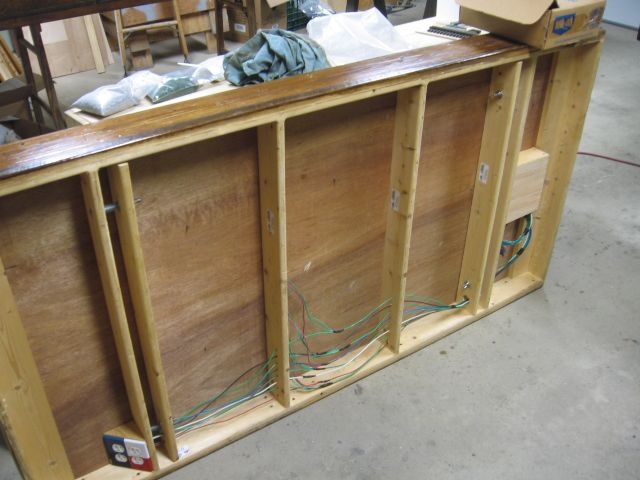
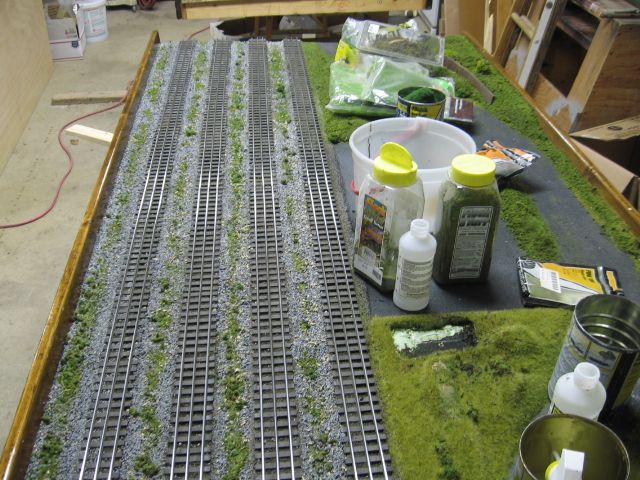
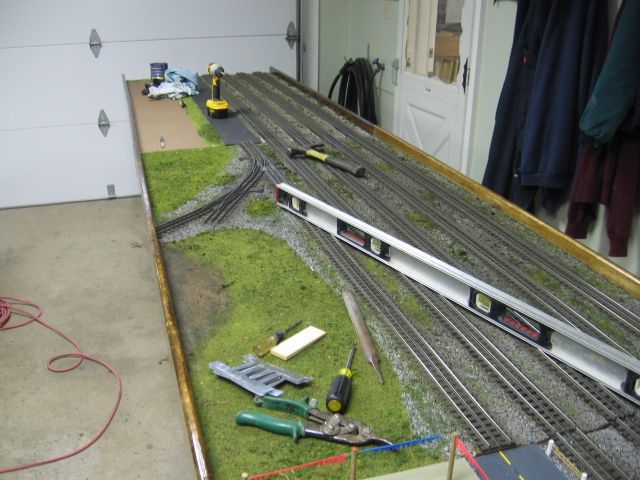
The corners are a similar fabrication. Note the cuts on the long frame boards to achieve the curve. These curves were fabricated 12 years ago. We are considering new curves after a lot of recent maintenance.

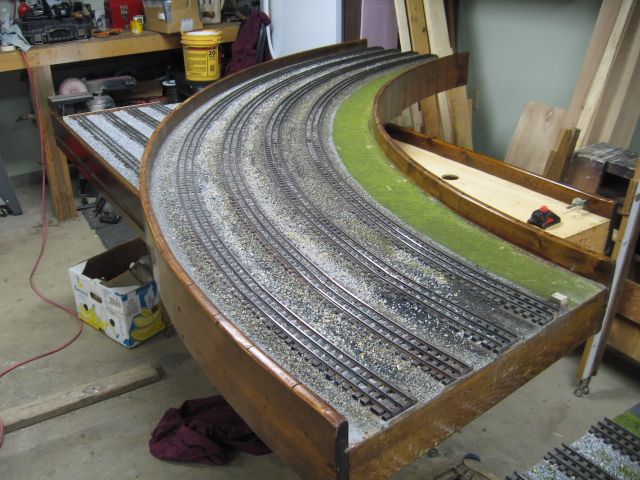
Recent fabrication, this module has even less structure, (less weight). Note that there are no face board on this module. To be added.
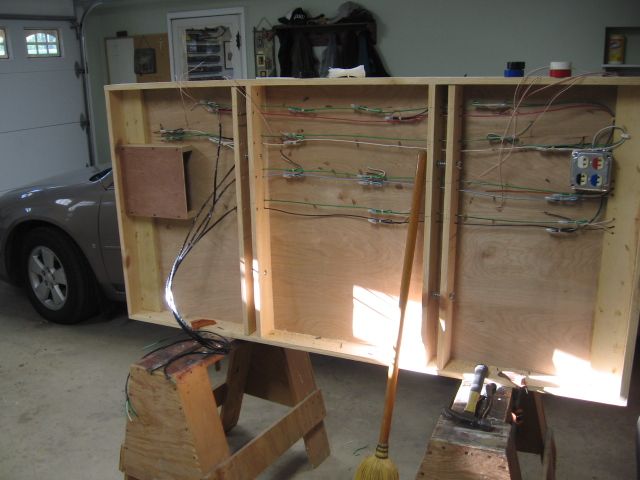
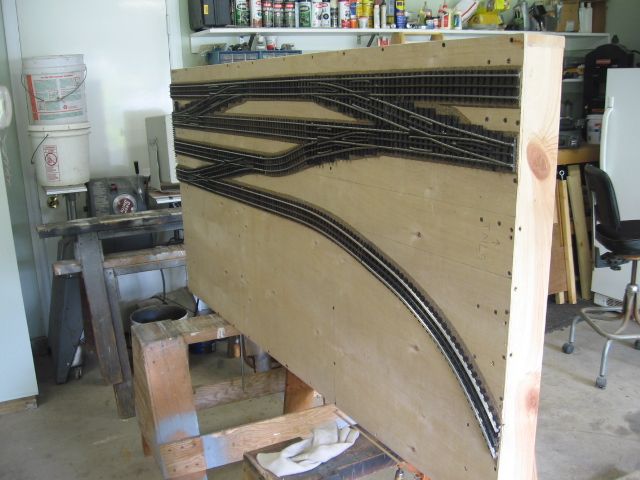
Different module with the legs installed.

Homosote is made out of the same material used to make drop ceilings. Unsupported in a humid environment it will sag.
2x4 24" on center with 2x4 legs every 4'. 3/4 9 ply plywood will never warp or sag with 1x2 homosote on top.
Ken M
Have to agree with Avanti above, as to using scraps of whatever i had around for my benchwork as it was all covered with Homasote roadbed and sheets of Homasote for my yards and concealed turning loop followed by scenery. In fact my concealed turning loop (approx. 4' x 6') consists of a sheet of 1/2" Homasote on top of 1/4" ply framed by 1x4 pine with 1x2 firing cross bracing every 12". It supports my 200+ lbs. without sagging.
Also in the interest of cost savings i found 1x6's ripped lengthwise into 1x3's (at no cost by my locally owned full service lumber yard) make very solid legs and cost less than 2x4's and are stronger than 2x2's. They've served me well for over 25 years now.
jackson
I used 2X3's, cheaper than 2X4's or 1X4's. For the layout top I used the cheapest ⅝ plywood sheathing I could find. I did use a few 2X4's for legs.
Some early construction pictures. (Some of this may be changing soon.):
Attachments
Why do folks use homasote on their layouts? Isn't that pretty expensive? Why not use 1/2" or 3/4" insulation foam board? I always thought that the foam board made for great scenery possibilities. Cutting culverts, streams, gully's, etc. I just looked up homasote on Home Depot's site and it was $28.00 per sheet. Is that the stuff??
Why do folks use homasote on their layouts? Isn't that pretty expensive? Why not use 1/2" or 3/4" insulation foam board? I always thought that the foam board made for great scenery possibilities. Cutting culverts, streams, gully's, etc. I just looked up homasote on Home Depot's site and it was $28.00 per sheet. Is that the stuff??
The main virtue of Homasote is acoustic. It is dense but soft, so it dampens track noise better than just about anything else. Having said that, you are certainly correct that pink/blue insulation foam is amazingly good for sculpting scenery, and many other things. Lots of us use it extensively. But for track, Homasote can't be beat. Plus, you can make wire holes with a screwdriver. ![]() $28 for a 4x8 sheet doesn't strike me as expensive, given that you don't really need a structural underlayment. Foam insulation would not be nearly strong enough to use alone, plus it would be very noisy. Can't anchor track screws in it, either (not that track screws are all that important).
$28 for a 4x8 sheet doesn't strike me as expensive, given that you don't really need a structural underlayment. Foam insulation would not be nearly strong enough to use alone, plus it would be very noisy. Can't anchor track screws in it, either (not that track screws are all that important).
As i read this discussion, it appears that many of you are enamored with the big box stores like Home Depot and Lowe's. I strongly suggest you try the local independent lumber yards for your building supplies. Sure they don't have everything out on displays where you can get all touchy feely, but they often make up for it with truly knowledgeable staff, great service (maybe even free delivery and millwork), and are very competitive in their pricing. They're usually the places professional builders and contractors get their supplies -- did you ever wonder why?
Homasote in my part of upstate NY at the local lumber yard is currently under $25 for a 4x8 sheet. That's over 10% less than the above (in Western NY) quoted Home Depot price. As i said earlier i used 2x3's ripped from 2x6's (at no charge by my local lumber yard & delivered free) for table legs at a cost much less than using 2x4's. And they are a lot straighter than some of the 2x4's i've seen at Home Depot.
jackson
Why do folks use homasote on their layouts? That's what they always used. Back when it was all that was available it served a purpose. I agree extruded foam is the way to go. Homosote is expensive and messy to cut up. Some people will recommend Quite Brace, but it is a regional product and not available everywhere. As one who is enamored with the big box stores, good luck finding a local building supply center. Having said that I bought all the material for my benchwork from a small Builders Surplus store.
I would totally like to shop at a real lumber yard, but the simple fact is that there is not a single one left at any reasonable distance from where I live. Home Depot is just up the road.
"Why do folks use homasote on their layouts?"
The main reason to use homasote is if one is hand spiking their track. Homasote excels for ability to take and hold spikes. It's also a quiet material to put under track but personally I like my trains to make lots of rail noise since I grew up in the noisy jointed rail boxcar era. My benchwork is generally 1X4 pine with 1/2 inch 5 ply plywood on top. I find this a good compromise between weight and strength. I place cross braces every 16 inch or less then add sawn 1/4 inch lauan plywood roadbed over the base plywood so sagging is not a problem. For areas with deeper features such as rivers or canyons I depress the layout framing then add risers to elevate the roadbed, then use foam stacked or screen wire to shape the contours. For legs 2X4's are fine and cheap, I don't like them for the benchwork framing as they are heavier and more in the way when wiring and installing things like switch motors under the benchwork....DaveB










